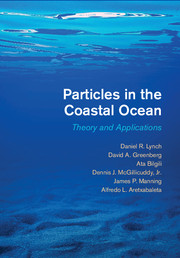Book contents
- Frontmatter
- Dedication
- Contents
- About the Authors
- Preface
- Acknowledgments
- List of Acronyms
- Definitions and Notation
- Introduction and Scope
- Part I Background
- 1 The Coastal Ocean
- 2 Drifters and Their Numerical Simulation
- 3 Probability and Statistics – A Primer
- 4 Dispersion by Random Walk
- 5 Boundary Conditions, Boundary Layers, Sources
- 6 Turbulence Closure
- Part II Elements
- Part III Applications
- Part IV Appendices
- A Series, Sums, Limits
- B Complex Numbers
- C Wiener Integrals
- D Rates and Rate Limiters
- E Diffusion Solutions
- F Covariance Matrix for Shear and Convergence
- G Summary – ARn Recursions
- H Distribution Properties for Linear Triangles
- Bibliography
- Index
- Plate Section
1 - The Coastal Ocean
from Part I - Background
Published online by Cambridge University Press: 05 January 2015
- Frontmatter
- Dedication
- Contents
- About the Authors
- Preface
- Acknowledgments
- List of Acronyms
- Definitions and Notation
- Introduction and Scope
- Part I Background
- 1 The Coastal Ocean
- 2 Drifters and Their Numerical Simulation
- 3 Probability and Statistics – A Primer
- 4 Dispersion by Random Walk
- 5 Boundary Conditions, Boundary Layers, Sources
- 6 Turbulence Closure
- Part II Elements
- Part III Applications
- Part IV Appendices
- A Series, Sums, Limits
- B Complex Numbers
- C Wiener Integrals
- D Rates and Rate Limiters
- E Diffusion Solutions
- F Covariance Matrix for Shear and Convergence
- G Summary – ARn Recursions
- H Distribution Properties for Linear Triangles
- Bibliography
- Index
- Plate Section
Summary
Man's interface with the ocean begins at the coast. Just the mention of estuaries, harbors, bays, lagoons, open coastline, and shelf seas conjures up a myriad of processes and scales with complex interactions. It is at the coast where human influences are most concentrated – waste disposal, construction, transportation, agriculture, aquaculture, recreation, mineral and biological exploitation. Equally, it is at the coast that the ocean most impacts humans, dictating patterns of everyday life and long-term viability. Oceanic motion mediates all these interactions, at several scales: surface waves, tide, storm surge, seasonal, decadal and beyond.
Our scope extends from land across the continental shelf to roughly the shelf break. The ocean dynamics change abruptly near the shelf break, as do many practical concerns including resource management, pollution, and navigation. This large, semienclosed region has come to be identified as the coastal ocean. Geographically the scope is approximately that of the Exclusive Economic Zone. The transport of matter within and through the coastal ocean is of paramount importance.
The understanding of water motion and its simulation in the coastal ocean is quite advanced. Many modeling methods are in use today that will give a faithful representation of currents and sea level. The resolution possible is surprisingly high and continually improving. Model output in the form of hind casts and even forecasts is growing in availability as well. These trends are likely to continue. Simultaneously the geographic coverage of models is expanding under national and international guidance.
It is the current fields from these models that are our starting point. We seek to use them, not produce them. Together with their companion fields (temperature, salinity, nutrients, turbulence) they constitute a sophisticated base from which to examine many important issues.
The common starting point is to examine the tracks that simple particles follow. It is the connections among time, place, and a particle's past that make this such an important matter.
- Type
- Chapter
- Information
- Particles in the Coastal OceanTheory and Applications, pp. 3 - 15Publisher: Cambridge University PressPrint publication year: 2014

